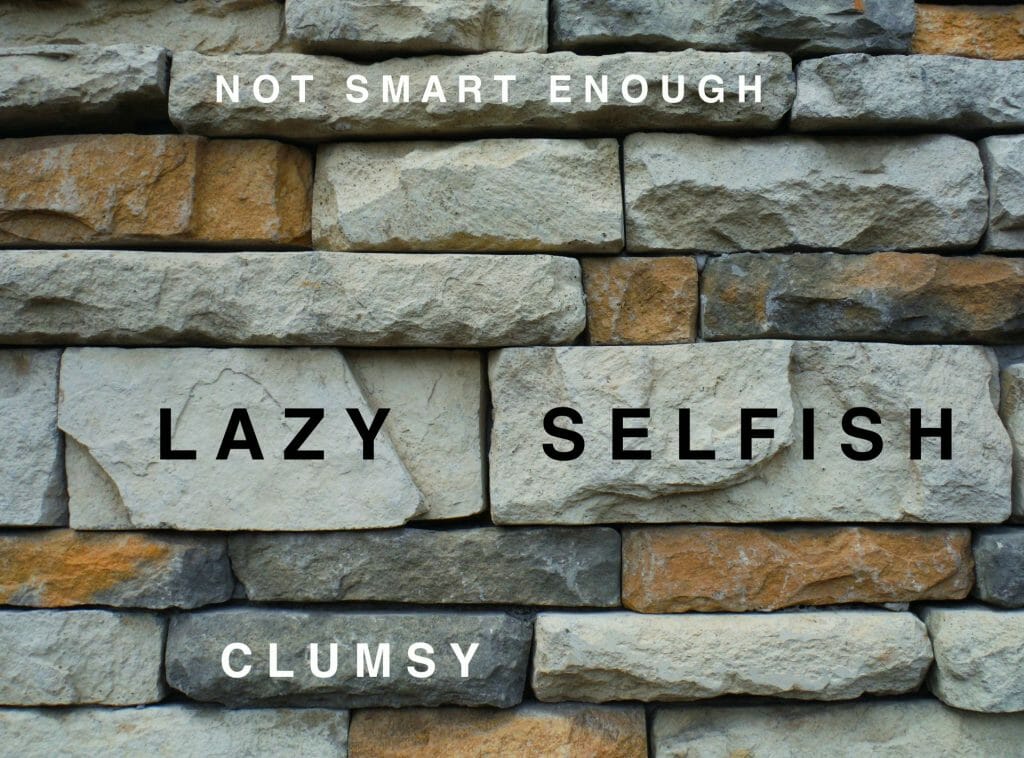To understand self-esteem, it’s handy to first get acquainted with another related term: Self-concept.
Self-Concept
Self-concept is the picture we’ve formed of who we are. It includes our understandings of our material self (body, possessions, habitat); our intrapersonal self (emotions, thoughts, values); and our interpersonal self (how we relate with others). Self-esteem, put simply, is how we feel about that picture.
Self-concept is built over time, brick by brick. Some of the most central bricks were laid in childhood, through interactions with parents, teachers, and other influential figures. If we were regularly labeled ‘lazy’ or ‘selfish’, then it’s a fair bet that lazy and selfish feature in our wall of self-concept. And a brick can be hard to shift when it’s firmly cemented into the middle of a wall.
If our wall becomes stacked with enough negative bricks, you can see how our self-esteem can take a nose-dive.

Marginalised Narratives
Understanding the origins of our self-concept is one way to address low self-esteem. Where did this ‘selfish’ label come from? What was going on for the person who conveyed this message? What are the stories that underpin this narrative?
If we are going to use ‘evidence’ to support a label, then it’s only fair that we consider conflicting evidence too. There are probably just as many stories in our past that provide evidence of generosity, kindness, and consideration for others. These stories are often marginalised, because they don’t fit with the dominant narratives we’ve come to accept.
As negative as some aspects of our self-concept may be, we often cling to them because they are known and familiar. Knowing who we are is better than not knowing, even if our ‘knowledge’ is built on subjective judgments.
Let’s face it, there is healthy and unhealthy in each one of us. We can be selfish and selfless, cruel and kind, accomplished and incompetent, mentally sharp and woefully forgetful. Accepting the fullness of who we are can be a first step in committing to the person we want to be now and into the future.

Three Simple Steps
Shifting negative self-esteem requires a gradual reconstruction of our self-concept, coupled with a level of acceptance for the very human flaws we all possess. Here are my three top tips for beginning that journey:
1. Values-based Actions:
We can spend hours mulling over the question ‘Am I a good person?’ Any answers we come up with can only be subjective and will be informed by the values we hold.
Instead, we can take time to identify and affirm our core values and consider some small actions we can take each day, which align with those values. For more on this, you may like to read another of my posts called Do Something Great.
2. Alternative Narratives:
Identify your top three unhelpful narratives about yourself. An unhelpful narrative is simply one which does not support you to be the person you want to be. Common examples might be:
- “I start things, but never see them through”
- “I am selfish and don’t think of others”
- “There’s no point going for opportunities because I’m not smart enough”
- “I’m unattractive, so why would anyone want to be with me?”
For each unhelpful narrative, identify the alternative stories screaming to be told. They often fail to get airplay because they just doesn’t fit with the dominant narrative.
Take time to delve into your memories and unearth the alternative stories hidden beneath. They may not be loud and proud, but they deserve to be heard. When we give fair hearing to the alternative stories, we begin to loosen some of those bricks that stand in the way of building positive self-esteem.
3. A Supportive Network:
Many of us are surrounded by people who help us keep that old wall in place. Family members can be particularly good at pushing back against our efforts to reinvent ourselves.
Spend more time with people who share your core values. A gradual transition is the way to go. Immediately cutting off all those you experience as unsupportive would be the social equivalent of quitting smoking, drinking and scratchies in the same week. You don’t need to do that to yourself.
Getting the Right Trades
At the risk of over-doing the brick wall analogy, I suggest that any renovation usually requires considered planning and the support of a trusted tradesperson. There is a diversity of practitioners out there who, like me, are passionate about creating safe and supportive spaces where growth and personal development can become a reality. So, get your three quotes, and get cracking today. A new, renovated you is just around the corner.




